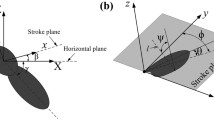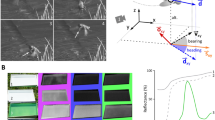Summary
Movement of a small object in the lateral visual field of a flying locust mounted on a balance induces a turning response expressed as a yaw towards the stimulus. Wing movements have been filmed (Figs. 2, 3, 4) and analysed in detail. During the response there are:
-
1.
A transient shortening of wing beat period (Fig. 5), more marked and occurring earlier, in the forewings.
-
2.
Fore and hindwing pairs move in phase at the start of the response. Contralateral wings tend to move out of phase, wing on side of turn follows that on other side initially but then changes can occur in either direction (Fig. 6).
-
3.
Forewing twisting was recorded. The forewing on the side of the turn remains pronated during the upstroke portion of the damped initial stroke.
-
4.
Wing stroke amplitude is reduced initially and then rapidly increases but, more importantly, the starting and finishing points of the contralateral wing strokes are different. Wings on the side of the turn start from a lower point and move down further than those on the opposite side (Figs. 7, 8).
-
5.
The hindleg on the side of the turn may be extended and the abdomen bent to that side also. This response develops and declines more slowly than the observed changes in wing motion.
It is postulated that these changes, in different combinations, can account for the observed behaviour and that in free flight the insect would perform a banked turn towards the stimulus.
Similar content being viewed by others
References
Baker, P.S.: Optomotor responses of the flying locust,Schistocerca gregaria. Ph. D. thesis, University of London (1976)
Baker, P.S.: Flying locust visual responses in a radial wind tunnel. J. Comp. Physiol.131, 39–47 (1979)
Baker, P.S., Cooter, R.J.: The natural flight of the Migratory Locust,Locusta migratoria L. I. Wing movements. J. Comp. Physiol.131, 79–87 (1979a)
Baker, P.S., Cooter, R.J.: The natural flight of the Migratory Locust,Locusta migratoria L. II. Gliding. J. Comp. Physiol.131, 89–94 (1979b)
Camhi, J.M.: Locust aerodynamic setae: sensory and interneurone responses. Am. Zool.7, 127 (1967)
Dugard, J.J.: Directional changes in flying locusts. J. Insect Physiol.13, 1055–1063 (1967)
Gettrup, E., Wilson, D.M.: The lift-control reaction of flying locusts. J. Exp. Biol.41, 183–190 (1964)
Gewecke, M.: The influence of the air-current sense organs on the flight behaviour ofLocusta migratoria. J. Comp. Physiol.103, 79–95 (1975)
Gewecke, M., Philippen, J.: Control of the horizontal flight-course by air-current organs inLocusta migratoria. Physiol. Ent.3, 43–52 (1978)
Goodman, L.J.: The role of certain optomotor reactions in regulating stability in the rolling plane during flight in the desert locust,Schistocerca gregaria. J. Exp. Biol.42, 385–407 (1965)
Jensen, M.: Biology and physics of locust flight, III. Phil. Trans. R. Soc. B239, 511–552 (1956)
Kennedy, J.S.: The migration of the desert locust,Schistocerca gregaria Forsk. Phil. Trans. R. Soc. B235, 163–290 (1951)
Koch, U.T.: A miniature movement detector applied to recording of wingbeat inLocusta. Fortschr. Zool.24, 327–332 (1977)
Möhl, B., Zarnack, W.: Activity of the direct downstroke flight muscles ofLocusta migratoria (L.) during steering behaviour in flight. II. Dynamics of the time shift and changes in the burst length. J.Comp. Physiol.118, 235–247 (1977)
Nachtigall, W.: Wie steuern die Insekten während des Fluges? Umschau17, 554 (1969)
Pfau, H.K.: Zur Morphologie und Funktion des Vorderflügelgelenks vonLocusta migratoria L. Fortschr. Zool.24, 339 (1977)
Sandeman, D.C.: Some aspects of the flight mechanism of the migratory locust,Locusta migratoria migratorioides R.F. Thesis presented for the degree of MSc, University of Natal (1961)
Snodgrass, R.E.: The thoracic mechanism of a grasshopper and its antecedents. Smithson. Misc. Collect.82, 1–111 (1929)
Weis-Fogh, T.: An aerodynamic sense organ stimulating and regulating flight in locusts. Nature (Lond.)164, 873–875 (1949)
Weis-Fogh, T.: Biology and physics of locust flight. II Flight performance of the desert locust,Schistocerca gregaria. Phil. Trans. R. Soc. B239, 459–510 (1956)
Wilson, D.M., Weis-Fogh, T.: Patterned activity of co-ordinated motor units, studied in flying locusts. J. Exp. Biol.39, 643–667 (1962)
Zarnack, W.: Kinematik der Flügelschlagbewegungen beiLocusta migratoria L. Dissertation, Naturwissenschaftliche Fakultät, München (1969)
Zarnack, W.: Flugbiophysik der Wanderheuschrecke (Locusta migratoria L.) I. Die Bewegungen der Vorderflügel. J.Comp. Physiol.78, 356–395 (1972)
Zarnack, W.: Locust flight control. On-line measurements of phase shifting in forening movements. Naturwissenschaften65, 64 (1978a)
Zarnack, W.: Transduces recording continuously 3-dimensional rotations of biological objects. J. Comp. Physiol.126, 161–168 (1978b)
Zarnack, W., Möhl, B.: Activity of the direct downstroke flight muscles ofLocusta migratoria (L.) during steering behaviour in flight. I. Patterns of time shift. J.Comp. Physiol.118, 215–233 (1977)
Author information
Authors and Affiliations
Additional information
I thank Drs R.J. Chapman and P.S. Baker of COPR for friendly help and advice during the course of this work and, together with Dr. P.L. MillerUniversity of Oxford, for resding and criticising the manuscript. Mr. B. Long assistes with some of the experiments reported here, his help is acknowledged.
Rights and permissions
About this article
Cite this article
Cooter, R.J. Visually induced yaw movements in the flying locust,Schistocerca gregaria (Forsk.). J. Comp. Physiol. 131, 67–78 (1979). https://doi.org/10.1007/BF00613085
Accepted:
Issue Date:
DOI: https://doi.org/10.1007/BF00613085




